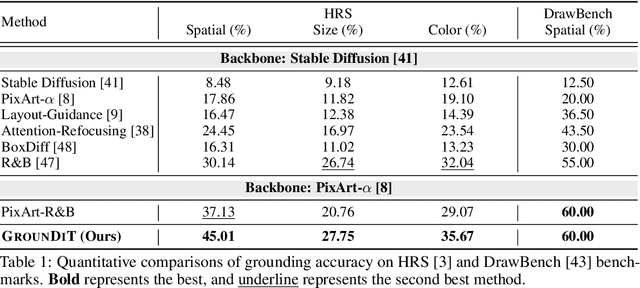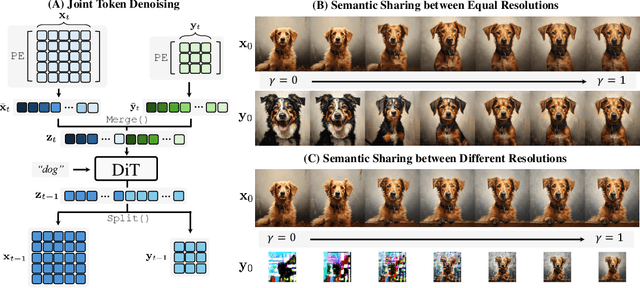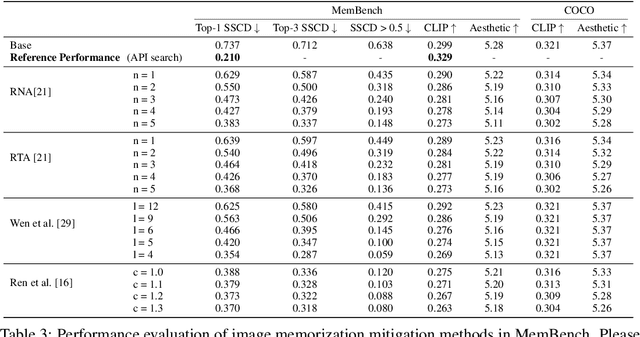Minhyuk Sung
Perspective-Aware Reasoning in Vision-Language Models via Mental Imagery Simulation
Apr 24, 2025Abstract:We present a framework for perspective-aware reasoning in vision-language models (VLMs) through mental imagery simulation. Perspective-taking, the ability to perceive an environment or situation from an alternative viewpoint, is a key benchmark for human-level visual understanding, essential for environmental interaction and collaboration with autonomous agents. Despite advancements in spatial reasoning within VLMs, recent research has shown that modern VLMs significantly lack perspective-aware reasoning capabilities and exhibit a strong bias toward egocentric interpretations. To bridge the gap between VLMs and human perception, we focus on the role of mental imagery, where humans perceive the world through abstracted representations that facilitate perspective shifts. Motivated by this, we propose a framework for perspective-aware reasoning, named Abstract Perspective Change (APC), that effectively leverages vision foundation models, such as object detection, segmentation, and orientation estimation, to construct scene abstractions and enable perspective transformations. Our experiments on synthetic and real-image benchmarks, compared with various VLMs, demonstrate significant improvements in perspective-aware reasoning with our framework, further outperforming fine-tuned spatial reasoning models and novel-view-synthesis-based approaches.
REWIND: Real-Time Egocentric Whole-Body Motion Diffusion with Exemplar-Based Identity Conditioning
Apr 08, 2025Abstract:We present REWIND (Real-Time Egocentric Whole-Body Motion Diffusion), a one-step diffusion model for real-time, high-fidelity human motion estimation from egocentric image inputs. While an existing method for egocentric whole-body (i.e., body and hands) motion estimation is non-real-time and acausal due to diffusion-based iterative motion refinement to capture correlations between body and hand poses, REWIND operates in a fully causal and real-time manner. To enable real-time inference, we introduce (1) cascaded body-hand denoising diffusion, which effectively models the correlation between egocentric body and hand motions in a fast, feed-forward manner, and (2) diffusion distillation, which enables high-quality motion estimation with a single denoising step. Our denoising diffusion model is based on a modified Transformer architecture, designed to causally model output motions while enhancing generalizability to unseen motion lengths. Additionally, REWIND optionally supports identity-conditioned motion estimation when identity prior is available. To this end, we propose a novel identity conditioning method based on a small set of pose exemplars of the target identity, which further enhances motion estimation quality. Through extensive experiments, we demonstrate that REWIND significantly outperforms the existing baselines both with and without exemplar-based identity conditioning.
ORIGEN: Zero-Shot 3D Orientation Grounding in Text-to-Image Generation
Mar 28, 2025Abstract:We introduce ORIGEN, the first zero-shot method for 3D orientation grounding in text-to-image generation across multiple objects and diverse categories. While previous work on spatial grounding in image generation has mainly focused on 2D positioning, it lacks control over 3D orientation. To address this, we propose a reward-guided sampling approach using a pretrained discriminative model for 3D orientation estimation and a one-step text-to-image generative flow model. While gradient-ascent-based optimization is a natural choice for reward-based guidance, it struggles to maintain image realism. Instead, we adopt a sampling-based approach using Langevin dynamics, which extends gradient ascent by simply injecting random noise--requiring just a single additional line of code. Additionally, we introduce adaptive time rescaling based on the reward function to accelerate convergence. Our experiments show that ORIGEN outperforms both training-based and test-time guidance methods across quantitative metrics and user studies.
Unconditional Priors Matter! Improving Conditional Generation of Fine-Tuned Diffusion Models
Mar 26, 2025



Abstract:Classifier-Free Guidance (CFG) is a fundamental technique in training conditional diffusion models. The common practice for CFG-based training is to use a single network to learn both conditional and unconditional noise prediction, with a small dropout rate for conditioning. However, we observe that the joint learning of unconditional noise with limited bandwidth in training results in poor priors for the unconditional case. More importantly, these poor unconditional noise predictions become a serious reason for degrading the quality of conditional generation. Inspired by the fact that most CFG-based conditional models are trained by fine-tuning a base model with better unconditional generation, we first show that simply replacing the unconditional noise in CFG with that predicted by the base model can significantly improve conditional generation. Furthermore, we show that a diffusion model other than the one the fine-tuned model was trained on can be used for unconditional noise replacement. We experimentally verify our claim with a range of CFG-based conditional models for both image and video generation, including Zero-1-to-3, Versatile Diffusion, DiT, DynamiCrafter, and InstructPix2Pix.
Inference-Time Scaling for Flow Models via Stochastic Generation and Rollover Budget Forcing
Mar 26, 2025Abstract:We propose an inference-time scaling approach for pretrained flow models. Recently, inference-time scaling has gained significant attention in LLMs and diffusion models, improving sample quality or better aligning outputs with user preferences by leveraging additional computation. For diffusion models, particle sampling has allowed more efficient scaling due to the stochasticity at intermediate denoising steps. On the contrary, while flow models have gained popularity as an alternative to diffusion models--offering faster generation and high-quality outputs in state-of-the-art image and video generative models--efficient inference-time scaling methods used for diffusion models cannot be directly applied due to their deterministic generative process. To enable efficient inference-time scaling for flow models, we propose three key ideas: 1) SDE-based generation, enabling particle sampling in flow models, 2) Interpolant conversion, broadening the search space and enhancing sample diversity, and 3) Rollover Budget Forcing (RBF), an adaptive allocation of computational resources across timesteps to maximize budget utilization. Our experiments show that SDE-based generation, particularly variance-preserving (VP) interpolant-based generation, improves the performance of particle sampling methods for inference-time scaling in flow models. Additionally, we demonstrate that RBF with VP-SDE achieves the best performance, outperforming all previous inference-time scaling approaches.
VideoHandles: Editing 3D Object Compositions in Videos Using Video Generative Priors
Mar 03, 2025Abstract:Generative methods for image and video editing use generative models as priors to perform edits despite incomplete information, such as changing the composition of 3D objects shown in a single image. Recent methods have shown promising composition editing results in the image setting, but in the video setting, editing methods have focused on editing object's appearance and motion, or camera motion, and as a result, methods to edit object composition in videos are still missing. We propose \name as a method for editing 3D object compositions in videos of static scenes with camera motion. Our approach allows editing the 3D position of a 3D object across all frames of a video in a temporally consistent manner. This is achieved by lifting intermediate features of a generative model to a 3D reconstruction that is shared between all frames, editing the reconstruction, and projecting the features on the edited reconstruction back to each frame. To the best of our knowledge, this is the first generative approach to edit object compositions in videos. Our approach is simple and training-free, while outperforming state-of-the-art image editing baselines.
StochSync: Stochastic Diffusion Synchronization for Image Generation in Arbitrary Spaces
Jan 26, 2025Abstract:We propose a zero-shot method for generating images in arbitrary spaces (e.g., a sphere for 360{\deg} panoramas and a mesh surface for texture) using a pretrained image diffusion model. The zero-shot generation of various visual content using a pretrained image diffusion model has been explored mainly in two directions. First, Diffusion Synchronization-performing reverse diffusion processes jointly across different projected spaces while synchronizing them in the target space-generates high-quality outputs when enough conditioning is provided, but it struggles in its absence. Second, Score Distillation Sampling-gradually updating the target space data through gradient descent-results in better coherence but often lacks detail. In this paper, we reveal for the first time the interconnection between these two methods while highlighting their differences. To this end, we propose StochSync, a novel approach that combines the strengths of both, enabling effective performance with weak conditioning. Our experiments demonstrate that StochSync provides the best performance in 360{\deg} panorama generation (where image conditioning is not given), outperforming previous finetuning-based methods, and also delivers comparable results in 3D mesh texturing (where depth conditioning is provided) with previous methods.
GrounDiT: Grounding Diffusion Transformers via Noisy Patch Transplantation
Oct 27, 2024



Abstract:We introduce a novel training-free spatial grounding technique for text-to-image generation using Diffusion Transformers (DiT). Spatial grounding with bounding boxes has gained attention for its simplicity and versatility, allowing for enhanced user control in image generation. However, prior training-free approaches often rely on updating the noisy image during the reverse diffusion process via backpropagation from custom loss functions, which frequently struggle to provide precise control over individual bounding boxes. In this work, we leverage the flexibility of the Transformer architecture, demonstrating that DiT can generate noisy patches corresponding to each bounding box, fully encoding the target object and allowing for fine-grained control over each region. Our approach builds on an intriguing property of DiT, which we refer to as semantic sharing. Due to semantic sharing, when a smaller patch is jointly denoised alongside a generatable-size image, the two become "semantic clones". Each patch is denoised in its own branch of the generation process and then transplanted into the corresponding region of the original noisy image at each timestep, resulting in robust spatial grounding for each bounding box. In our experiments on the HRS and DrawBench benchmarks, we achieve state-of-the-art performance compared to previous training-free spatial grounding approaches.
MemBench: Memorized Image Trigger Prompt Dataset for Diffusion Models
Jul 24, 2024



Abstract:Diffusion models have achieved remarkable success in Text-to-Image generation tasks, leading to the development of many commercial models. However, recent studies have reported that diffusion models often generate replicated images in train data when triggered by specific prompts, potentially raising social issues ranging from copyright to privacy concerns. To sidestep the memorization, there have been recent studies for developing memorization mitigation methods for diffusion models. Nevertheless, the lack of benchmarks impedes the assessment of the true effectiveness of these methods. In this work, we present MemBench, the first benchmark for evaluating image memorization mitigation methods. Our benchmark includes a large number of memorized image trigger prompts in Stable Diffusion, the most popularly used model nowadays. Furthermore, in contrast to the prior work evaluating mitigation performance only on trigger prompts, we present metrics evaluating on both trigger prompts and general prompts, so that we can see whether mitigation methods address the memorization issue while maintaining performance for general prompts. This is an important development considering the practical applications which previous works have overlooked. Through evaluation on MemBench, we verify that the performance of existing image memorization mitigation methods is still insufficient for application to diffusion models.
MV2Cyl: Reconstructing 3D Extrusion Cylinders from Multi-View Images
Jun 16, 2024Abstract:We present MV2Cyl, a novel method for reconstructing 3D from 2D multi-view images, not merely as a field or raw geometry but as a sketch-extrude CAD model. Extracting extrusion cylinders from raw 3D geometry has been extensively researched in computer vision, while the processing of 3D data through neural networks has remained a bottleneck. Since 3D scans are generally accompanied by multi-view images, leveraging 2D convolutional neural networks allows these images to be exploited as a rich source for extracting extrusion cylinder information. However, we observe that extracting only the surface information of the extrudes and utilizing it results in suboptimal outcomes due to the challenges in the occlusion and surface segmentation. By synergizing with the extracted base curve information, we achieve the optimal reconstruction result with the best accuracy in 2D sketch and extrude parameter estimation. Our experiments, comparing our method with previous work that takes a raw 3D point cloud as input, demonstrate the effectiveness of our approach by taking advantage of multi-view images.
 Add to Chrome
Add to Chrome Add to Firefox
Add to Firefox Add to Edge
Add to Edge